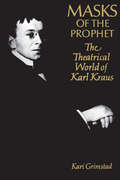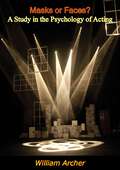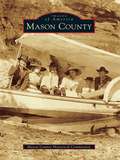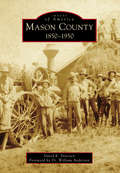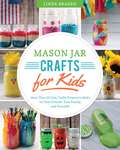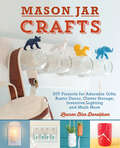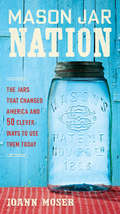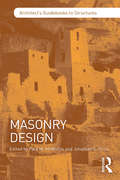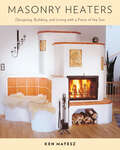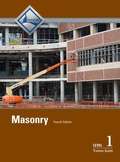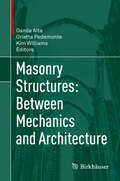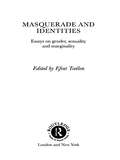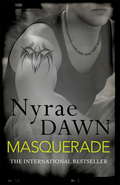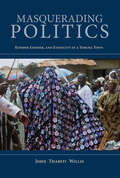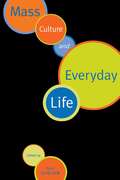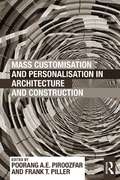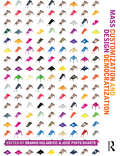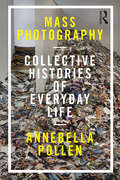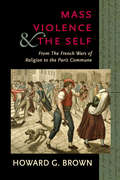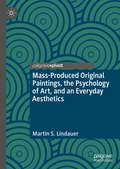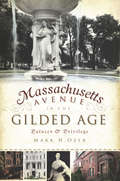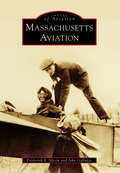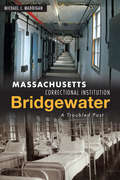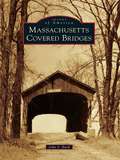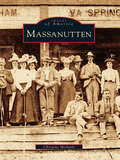- Table View
- List View
Masks of the Prophet: The Theatrical World of Karl Kraus
by Karl Grimstad'When the name "Hitler" is mentioned, nothing occurs to me' – so said Karl Kraus. For this leading Viennese Jewish critic and intellectual the touchstone of art was ethics. How could he be speechless in the face of a threat to all that ethics means? To answer this question, the author makes a detailed chronological study of Kraus's intellectual activity as reflected in his work on the theatre. The results are presented in five chapters, each dealing with a different 'mask' adopted by Kraus during the period 1892-1936. Grimstad considers not only theatre and drama criticism in Die Fackel and Kraus's dramatic writings, but also biographical data, to help uncover the rationale of his work. That rationale is the logic of the theatrical mode in which he lived and wrote. The stage was not only his subject matter, it determined what he would see and say. Grimstad argues that when Kraus wrote, his words were the speech of an 'actor' who was often infatuated with himself and obsessed with the need to overwhelm his rival 'actors.' When Hitler's storm-troopers began their march, he could say nothing for the world in which his thought took shape had become a world of theatrics, not 'Realpolitik.' Kraus criticized plays without reading them and performances without seeing them, obsessed with the belief that his was the voice of all that was true, good, and beautiful. Grimstad observes that he was a prophet who confused the divine inspiration with the Thespian urge, playing to an audience, using a mask for each of his roles, yet thinking he spoke to all mankind, bringing them pure ethos. This volume will be of particular interest to those working in the fields of theatre criticism, comparative literature, German literature, and Jewish intellectual history.
Masks or Faces?: A Study in the Psychology of Acting
by William Archer"Masks or Faces?: A Study in the Psychology of Acting" by William Archer is a seminal work that delves into the intricate world of acting, exploring the delicate balance between an actor's external performance and their internal psychological processes. Archer, a renowned theatre critic and playwright, provides a thorough analysis of the art and craft of acting, addressing the age-old question of whether actors genuinely experience the emotions they portray or merely simulate them.In this groundbreaking study, Archer examines various theories and techniques of acting, drawing on his extensive knowledge of theatre history and his keen observations of performances. He discusses the methods employed by different acting schools, from the classical traditions to the emerging naturalistic styles of his time. By dissecting the techniques of notable actors and their ability to convey authentic emotions, Archer provides readers with a comprehensive understanding of the psychological underpinnings of effective acting."Masks or Faces?" also explores the concept of the actor's dual identity—the mask they wear on stage versus their true self. Archer delves into the psychological impact of this duality on actors, considering how their craft influences their personal identities and emotional well-being. Through insightful anecdotes and critical analysis, he sheds light on the complexities of an actor's life, both on and off the stage.This book is an essential read for students of theatre, actors, directors, and anyone interested in the psychology of performance. Archer's eloquent writing and profound insights make "Masks or Faces?" a timeless exploration of the fascinating interplay between reality and illusion in the world of acting. It remains a vital resource for understanding the psychological depth required to bring characters to life and the enduring question of whether actors truly live the emotions they portray or skillfully craft an illusion for their audience.
Mason County
by Mason County Historical CommissionWhen an army scouting party headed north from Fredericksburg in 1851 to select a site for a new military post, they found an area of remarkable natural beauty on the northwestern edge of the Texas Hill Country. This land of clear streams, rocky hills, live oak thickets, and abundant wildlife had long served as a hunting ground for Comanches, Kiowas, and Lipan Apaches. A few German farmers had already settled along the Llano River, and a town soon sprang up in the shadow of Fort Mason. By the 1920s, Mason County's population included German Americans, descendants of old families from the southeastern states, Mexican immigrants who had fled the revolution, and African Americans whose ancestors had arrived in the 1850s. For decades, the region has attracted hunters, river enthusiasts, naturalists, and geologists. The town of Mason features one of the most picturesque courthouse squares in Texas. Its old-time storefronts and handsome sandstone houses make it a popular tourist destination today.
Mason County: 1850-1950
by Dr William Anderson David K. PetersenMason County: 1850-1950 portrays the settlement and growth of Mason County, Michigan, as the area transformed from a land covered in virgin pine and native settlements to communities of farmers and manufacturers. This history of the region begins with images of logging and mills and follows the growth of towns, villages, and individual townships. The adversity, struggles, successes, and joys of carving a new life from the wilderness are captured in more than 200 carefully selected images. These unique photographs illustrate a life of hardship, service, and dedication to faith, family, and community as the area transitioned and changed over the decades.
Mason Jar Crafts for Kids: More Than 25 Cool, Crafty Projects to Make for Your Friends, Your Family, and Yourself!
by Linda BradenMason jars are no longer just for canning. Today we use them to drink from, to cook inside, and--with almost limitless possibilities--to craft with. In this fabulous new book, Linda Braden, author and owner of MasonJarCraftsLove. com and ItAllStartedWithPaint. com, offers up a collection of fun and creative Mason jar crafts for kids. Her ideas include everything from wild science experiments and delicious edible treats to holiday decor and gifts for the whole family. Kids won’t want to miss the fireworks in a jar or the lava lamp jar projects. And who could resist a Mason jar cupcake or a rainbow Jell-O jar? There are instructions for how to make your own lantern jars, snow globes, and even a Mason jar terrarium. This book will keep little hands busy all year round, with dozens of easy do-it-yourself projects. Accompanied by photo tutorials and helpful step-by-step instructions, these projects are kid-friendly and offer a variety of options for both beginning and more advanced DIY fans. Each project is complete with age recommendations, a list of supplies you will need, and safety precautions. These projects are great for crafting with a big group or alone with your child, and perfect for long summer days, rainy weekends, and holiday preparation. Be inspired and discover the endless possibilities with the world’s most famous jar!
Mason Jar Crafts: DIY Projects for Adorable and Rustic Decor, Storage, Lighting, Gifts and Much More
by Lauren Elise DonaldsonVINTAGE MASON JARS, MODERN STYLEPacked with dozens of easy do-it yourself projects, this book shows how to transform the forever fashionable Mason jar into everything from a festive party decoration or fun children's toy to an elegant wedding favor or useful home decoration, including:* Cake Stand* Calligraphy Drink Glasses* Holiday Candelabra* Terrarium* Night Light* Piggy Bank* Clock* Herb Garden* Animal Hooks. With helpful instructions and over 150 step-by-step photos, Mason Jar Crafts will have you fashioning inexpensive and stylish projects in no time.
Mason Jar Nation: The Jars That Changed America and 50 Clever Ways to Use Them Today
by JoAnn MoserLearn how to make over fifty Mason jar projects, including luminaries, planters, and upcycled art, with this amazing guide.Mason Jar Nation begins by exploring the Mason jar's impact on America since its 1858 patent. Prior to the jar's invention, settlers had no reliable and safe way to store food for the winter, which required them to travel great lengths in difficult conditions and obtain expensive canned goods in order to survive. With its hermetically sealable two-piece lid and thick glass sides, the Mason jar changed the way mid-nineteenth century Americans fed their families.Although the popularity of the jars ebbed significantly from the 1950s until the turn of the century, interest in them has exploded in the past few years. Ball, the biggest brand name in Mason jars today, has seen its sales double since 2001. Younger generations, including Millennials, have adopted the iconic jars as emblems of a more sustainable time. The humble Mason jar has been "discovered" as a versatile and beautiful material for creating craft items such as chandeliers, luminaries, planters, containers, and upcycled art.The second half of Mason Jar Nation features over fifty of these adaptations, shown with clear photography, all designed and photographed by author JoAnn Moser, the "DIY Maven." Readers who appreciate American cultural history, making fun and affordable crafts, and Mason jars themselves will love this book.
Masonry Design (Architect's Guidebooks to Structures)
by Paul W. McMullin Jonathan S. PriceMasonry is found extensively in construction throughout the world. It is economical and strong. Masonry Design—part of the Architect’s Guidebook to Structures series—presents the fundamentals in an accessible fashion through beautiful illustrations, simple and complete examples, and from the perspective of practicing professionals with hundreds of projects under their belt and decades of teaching experience. Masonry Design provides the student with and reminds the practitioner of fundamental masonry design principles. Beginning with an intriguing case study of the Mesa Verde National Park visitor center, the subsequent chapters present the fundamentals of masonry design, bending, shear, compression design, wind and seismic design, and connection design. It is a refreshing change in textbooks for architectural materials courses and is an indispensable reference for practicing architects.
Masonry Heaters: Designing, Building, and Living with a Piece of the Sun
by Ken MateszA complete guide to designing and living with one of the oldest, and yet one of the newest, heating devices. A masonry heater&’s design, placement in the home, and luxurious radiant heat redefine the hearth for the modern era, turning it into a piece of the sun right inside the home. Like the feeling one gets from the sun on a spring day, the environment around a masonry heater feels fresh. The radiant heat feels better on the skin. It warms the home both gently and efficiently. In fact, the value of a masonry heater lies in its durability, quality, serviceability, dependability, and health-supporting features. And it is an investment in self-sufficiency and freedom from fossil fuels.The book discusses different masonry heater designs, including variations extant in Europe, and explains the growth of their popularity in the United States beginning in the late 1970s. For the reader who may be familiar only with open fireplaces and metal woodstoves, Masonry Heaters will bring a new understanding and appreciation of massive heat storage and gentle-but-persistent radiant heat. Masonry heaters offer a unique comfort that is superior to that from convection heat from forced-air systems, and more personal than that offered by &“radiant&” floors. As Matesz demonstrates, the heat from the sun or from a masonry heater is genuine heat instead of just insulation against the loss of heat.Those who are looking to build, add onto, or remodel a house will find comprehensive and practical advice for designing and installing a masonry heater, including detailed discussion of materials, code considerations, and many photos and illustrations. While this is not a do-it-yourself guide for building a masonry heater, it provides facts every heater builder should know. Professional contractors will find this a useful tool to consult, and homeowners considering a new method of home heating will find all they need to know about masonry heaters within these pages."Ken Matesz shares his love of masonry heaters and artfully explains how they work, how to use them to provide efficient and comfortable heat throughout the day, and what it takes to install one in your home. This is a truly delightful book."—David Bainbridge, Author of The Straw Bale House, and Passive Solar Architecture
Masonry Level One Trainee Guide (4th Edition)
by Nccer<p>The newest edition of <i>Masonry Level One</i> presented by NCCER contains updates to the curriculum that will engage you and give you the best training possible. In this edition, you will find that the layout has changed to better align with the learning objectives. There are also new end-of-section review questions to compliment the module review. <p>The text, graphics, and special features were enhanced to reflect advancements in masonry technology and techniques. The three levels present an apprentice approach to the masonry field and helps keep you knowledgeable, safe, and effective on the job.</p>
Masonry Structures: Between Mechanics and Architecture
by Kim Williams Danila Aita Orietta PedemonteThe book aims to provide an overview of the state of the art on the mechanics of arches and masonry structures. It is addressed to an international audience, arising from the international context in which the Associazione Edoardo Benvenuto has carried out its activities in recent years, under the honorary presidency of Jacques Heyman. The book belongs to the collection Between Mechanics and Architecture, born in 1995 from the collaboration of several renowned scholars, including Edoardo Benvenuto (P. Radelet-de Grave, E. Benvenuto (eds. ), Entre Mécanique et Architecture / Between Mechanics and Architecture, Birkhäuser, Basel 1995).
Masquerade and Identities: Essays on Gender, Sexuality and Marginality
by Efrat TseëlonMasquerade, both literal and metaphorical, is now a central concept on many disciplines. This timely volume explores and revisits the role of disguise in constructing, expressing and representing marginalised identities, and in undermining easy distinctions between 'true' identity and artifice.The book is interdisciplinary in approach, spanning a diverse range of cultures and narrative voices. It provides provocative and nuanced ways of thinking about masquerade as a tool for construction, and a tool for critique. The essays interrogate such themes as:*mask and carnival*fetish fashion*stigma of illegitimacy*femininity as masquerade*lesbian masks*cross-dressing in Jewish folk theatre*the mask in seventeenth and eighteenth century London and nineteenth century France*the voice as mask.
Masquerade: The Games Trilogy 3 (The Games Trilogy)
by Nyrae DawnIf you love Jamie McGuire's Beautiful Disaster and Walking Disaster and Abbi Glines, THE GAMES trilogy is for you.BOOK 3 in THE GAMES trilogy. After his father is imprisoned for murder, leaving his mother suicidal, Maddox Cross is left alone in Brenton, Virginia. When he meets a feisty young woman in the club where he works security, he has no idea that she might change his life for ever.Bee Malone has just moved to Brenton to open a tattoo parlour, Masquerade. But Bee hides a dark past. When she meets Maddox, there's an instant attraction that leaves them wanting to connect in more ways than one. Maddox is fascinated by Bee's passion for ink, and asks her to teach him her art. As they work side by side at Masquerade, sparks fly and they are both forced out of their comfort zones. Will their stubborn natures tear them apart? Or push them dangerously closer together?
Masquerading Politics: Kinship, Gender, and Ethnicity in a Yoruba Town
by John Thabiti WillisIn West Africa, especially among Yoruba people, masquerades have the power to kill enemies, appoint kings, and grant fertility. John Thabiti Willis takes a close look at masquerade traditions in the Yoruba town of Otta, exploring transformations in performers, performances, and the institutional structures in which masquerade was used to reveal ongoing changes in notions of gender, kinship, and ethnic identity. As Willis focuses on performers and spectators, he reveals a history of masquerade that is rich and complex. His research offers a more nuanced understanding of performance practices in Africa and their role in forging alliances, consolidating state power, incorporating immigrants, executing criminals, and projecting individual and group power on both sides of the Afro-Atlantic world.
Mass Culture and Everyday Life
by Peter GibianMass Culture and Everyday Life is a collection of lively work from the small but seminal journal Tabloid. The book offers a clarification of the study of mass culture as it transforms daily life, providing a detailed survey of a wide range of the mass culture phenomena that have defined our everyday lives in recent years: from Hillary's hairdo to tampons, exercise fads and fashion trends; from soaps to opera to rythmn and blues; from horror movies to the interrelation of cats, pigs and mothers in Babe. This volume includes ground-breaking essays on: the boom of talk radio and talk TV; shopping as cinematic spectacle; and how "everyday life" in the university community has become a key battleground in America's "culture wars." The direct, accessible, and refreshingly personal work speak not only to an academic audience but to a wide general readership.
Mass Customisation and Personalisation in Architecture and Construction
by Frank T. Piller Poorang A.E. PiroozfarChallenged by the recent economic crisis, the building and construction industry is currently seeking new orientation and strategies. Here mass customisation is uncovered as a key strategy in helping to meet this challenge. The term mass customisation denotes an offering that meets the demands of each individual customer, whilst still being produced with mass production efficiency. Today mass customisation is emerging from a pilot stage into a scalable and sustainable strategy... The first dedicated publication of its kind, this book provides a forum for the concept within an applied and highly innovative context. The book includes contributions from some of the most prominent thinkers and practitioners in the field from across the world, including Kasper S. Vibaek, Steve Kendall, Martin Bechthold, Mitchell M. Tseng, and Masa Noguchi. Bringing together this panel of experts who have carried out research both in academia and practice, this book provides an overview of state-of-the-art practice related to the concept of customisation and personalisation within the built environment.
Mass Customization and Design Democratization
by Branko Kolarevic José Pinto DuarteParametric design and digital fabrication are enabling non-designers to mass produce non-standard, highly differentiated products – from shoes and tableware to furniture and even houses. The result of these newly available mass customization tools has been a ‘democratization’ of design. Mass Customization and Design Democratization is the first book to address this recent phenomenon. Demonstrating how the considerable potential of these tools can be realized in practice, it introduces essential technologies and design approaches and provides numerous examples of the latest, cutting edge work from leading design firms, manufacturers and thinkers. The book examines what mass customization means for architecture and the building industry and investigates its impact on the sector’s most commoditized enterprise – suburban housing. Asking whether design democratization is viable in the current context and exploring what kind of mass customization is possible, useful, and desirable, it poses fundamental questions about the authorship of design and the functional and aesthetic quality of products designed by non-designers. A highly designed book featuring over 200 color illustrations, this is essential reading for professionals as well as students taking courses in digital architecture, parametric design, and mass customization.
Mass Photography: Collective Histories of Everyday Life (International Library Of Visual Culture Ser.)
by Annebella PollenWith increasingly accessible camera technology, crowdsourced public media projects abound like never before. Such projects often seek to secure a snapshot of a single day in order to establish communities and create visual time capsules for the future. Mass Photography: Collective Histories of Everyday Life assesses the potential of these popular moment-in-time projects by examining their current day prevalence and their historical predecessors. Through archival research and interviews with organisers and participants, it examines, for the first time, the vast photographic collections resulting from such projects, analysing their structures and systems, their aims and objectives, and their claims and promises. The central case study is the 55,000 photographs submitted to One Day for Life in 1987, which aimed, in its own time, to be ‘the biggest photographic event the world had ever seen’.
Mass Violence and the Self: From the French Wars of Religion to the Paris Commune
by Howard G. BrownMass Violence and the Self explores the earliest visual and textual depictions of personal suffering caused by the French Wars of Religion of 1562–98, the Fronde of 1648–52, the French Revolutionary Terror of 1793–94, and the Paris Commune of 1871. The development of novel media from pamphlets and woodblock printing to colored lithographs, illustrated newspapers, and collodion photography helped to determine cultural, emotional, and psychological responses to these four episodes of mass violence.Howard G. Brown’s richly illustrated and conceptually innovative book shows how the increasingly effective communication of the suffering of others combined with interpretive bias to produce what may be understood as collective traumas. Seeing these responses as collective traumas reveals their significance in shaping new social identities that extended beyond the village or neighborhood. Moreover, acquiring a sense of shared identity, whether as Huguenots, Parisian bourgeois, French citizens, or urban proletarians, was less the cause of violent conflict than the consequence of it. Combining neuroscience, art history, and biography studies, Brown explores how collective trauma fostered a growing salience of the self as the key to personal identity. In particular, feeling empathy and compassion in response to depictions of others’ emotional suffering intensified imaginative self-reflection. Protestant martyrologies, revolutionary "autodefenses," and personal diaries are examined in the light of cultural trends such as the interiorization of piety, the culture of sensibility, and the birth of urban modernism to reveal how representations of mass violence helped to shape the psychological processes of the self.
Mass-Produced Original Paintings, the Psychology of Art, and an Everyday Aesthetics
by Martin S. LindauerThis book examines the contribution of mass-produced original painting to the psychology of art, psychological aesthetics, and art criticism. Mass-produced paintings are an inexpensive, accessible, ubiquitous, and hand-painted popular art by anonymous artists or teams. Sold in an array of outlets, ranging from flea markets to shopping centers to cruise ships, they decorate hotels, offices, and homes. Addressed is their neglect in current scholarship in favor of a nearly exclusive investigation of the high arts and their audiences, as represented by museum paintings. Lindauer contextualizes his analysis by tracing the historical origins of this type of painting, popular art in general, and their evolutionary trajectory, exploring issues including: the impact of art and artists’ creativity on viewers; the overemphasis on originality and name recognition; what is art and who can be called an artist; and the extension of aesthetics to include an everyday kind. The book concludes with directions for future research in the popular and traditional arts, the psychology of art, and, more broadly, the ties that transcend barriers between science, the arts, and the humanities. It will appeal to students and scholars from across the fields of psychology, sociology, philosophy, art history, and cultural, media and communication studies.
Massachusetts Avenue in the Gilded Age: Palaces & Privilege
by Mark N. OzerWelcome to Millionaire's Row, where the Gilded Age mansions and clubs of high society still exude a faded elegance. It was here that fiery Martha Wadsworth--avid sportswoman and social maven--and wealthy hostess Nellie Patterson mingled with the likes of famous inventor Alexander Graham Bell and miner-turned-millionaire Thomas Walsh. From the Union Station Plaza and Embassy Row to Dupont Circle and the Washington National Cathedral, author Mark N. Ozer examines the extant Beaux-Arts architecture of Massachusetts Avenue mansions and tells the tales of socialites and politicians who lived and played behind their grand façades.
Massachusetts Aviation (Images of Aviation)
by John Galluzzo Frederick R. MorinShortly after the Wright brothers took to the air, aviation fever gripped Massachusetts. The biggest names in the industry, including Wilbur Wright, Glenn Curtiss, and Claude Graham-White, among others, flew in for the first major air shows, further exciting the people of the Bay State about the potential of manned flight in the realms of military tactics, the expansion of commerce, and even personal transportation. By the 1920s, Massachusetts had become home to the first Naval Air Reserve Base, in Quincy; one of the first Coast Guard Air Stations, in Gloucester; and the Boston Airfield, which would become the largest international airport in New England. Within a few decades, individuals like Edward Lawrence Logan, Frank Otis, Oscar Westover, and Laurence G. Hanscomb would permanently leave their names on the Massachusetts landscape in connection with the airports and airfields still used today.
Massachusetts Correctional Institution-Bridgewater: A Troubled Past (Landmarks)
by Michael J. MaddiganOnce known as MCI-Bridgewater and earlier as the Massachusetts State Farm, the Bridgewater Correctional Complex opened in 1854. It was one of several progressive charitable institutions the state created as a model for communities around the world. However, deteriorating conditions for its residents shadowed Bridgewater's evolution from an almshouse to a prison and hospital for the criminally insane. A century later, it was among the nation's most notorious asylums. Historian Michael J. Maddigan offers a riveting examination of this infamous history, including the inspiration for state-sponsored welfare, moral and legal challenges and the experiences of the people who lived and worked there.
Massachusetts Covered Bridges
by John S. BurkFrom hidden valleys in the Berkshire Hills to the North Shore, 275 documented highway and railroad covered bridges have been constructed in Massachusetts from the early 19th century onward, a figure that often comes as a surprise to those who traditionally associate these unique structures with northern New England. All but a small handful of these are long gone, lost to modern replacements, fires, wear, and the region's notorious weather, especially the devastating storms of the late 1930s. The bridges came in all shapes and sizes, from diminutive 50-foot spans to multitiered structures of nearly 900 feet that crossed the Merrimack and Connecticut Rivers and were stout enough to support railroads across their roofs.
Massanutten
by Christine MichaelsMassanutten, a 50-mile-long mountain range, ends in a striking peak in the Shenandoah Valley of western Virginia, splitting the Blue Ridge Mountains fromthe Alleghenies and the North and South Forks of theShenandoah River. Once an area where Native Americansdwelled and perhaps cultivated the land, Massanutten boasted healing springs that blossomed to become a four-season resort. Private homes intermingle with a conference center, timeshares, and condominiums in an area of preserved woodland heritage. This volume chronicles the history and development of this part of the mountain range, from its use as a Civil War lookout point to a modern-day ski resort complete with golfing and a water park. Included are glimpses of sports, business, and political notables like Lance Armstrong, Del Webb, and Bob Mathias, who have made their marks here--either as guests or in the development of the resort itself.
